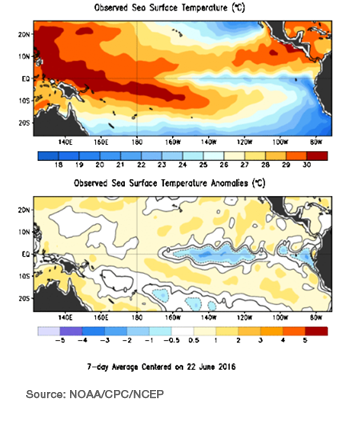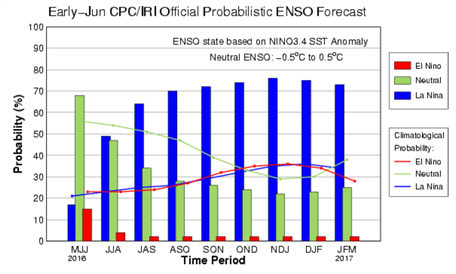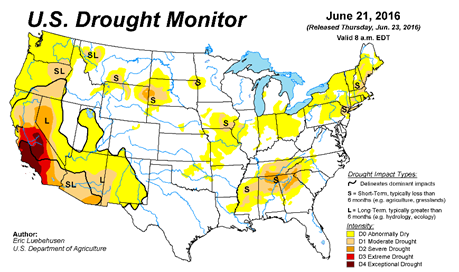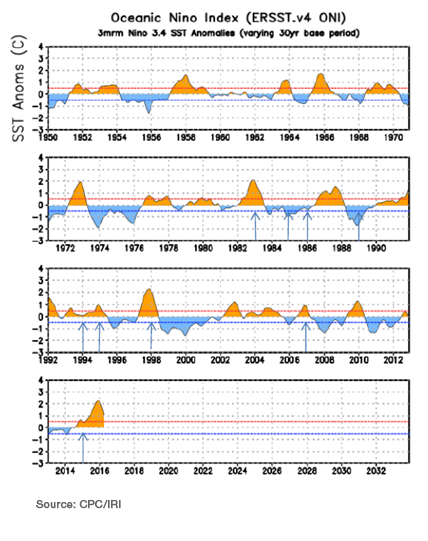 Most weather watchers now agree it’s a question of when, not if, La Niña will impact weather. La Niña, the cool-water alter ego of El Niño, already is arising from the depths of the Pacific. As the maps below show, the sea surface temperature anomalies have shifted to blue – indicating cooler than neutral - along the equator.
Most weather watchers now agree it’s a question of when, not if, La Niña will impact weather. La Niña, the cool-water alter ego of El Niño, already is arising from the depths of the Pacific. As the maps below show, the sea surface temperature anomalies have shifted to blue – indicating cooler than neutral - along the equator.
 To be qualified as a full-fledged La Niña, the index must be -0.5oC for five consecutive three-month seasons (6 months). As can be seen in the graph below (blue bars), the July-August-September “season” shows a probability of 60 percent, climbing to more than 70 percent by November-January.
To be qualified as a full-fledged La Niña, the index must be -0.5oC for five consecutive three-month seasons (6 months). As can be seen in the graph below (blue bars), the July-August-September “season” shows a probability of 60 percent, climbing to more than 70 percent by November-January.
 Should La Niña move in fast, this year’s yields could be at risk due to the warmer-and-drier-than-usual weather that often accompanies La Niña. Already, June had above-average temperatures and below-average precipitation in the Corn Belt, as evidenced by the U.S. Drought Monitor (map below). In its three-month outlooks, the Climate Prediction Center projects above normal temperatures for all the contiguous states, although its outlooks currently show mainly equal chances for above, normal or below normal rainfall.
Should La Niña move in fast, this year’s yields could be at risk due to the warmer-and-drier-than-usual weather that often accompanies La Niña. Already, June had above-average temperatures and below-average precipitation in the Corn Belt, as evidenced by the U.S. Drought Monitor (map below). In its three-month outlooks, the Climate Prediction Center projects above normal temperatures for all the contiguous states, although its outlooks currently show mainly equal chances for above, normal or below normal rainfall.
Jeff Doran, meteorologist with Planalytics, based in Berwyn, Pa., told those attending a recent Bloomberg client meeting that he bases his outlooks not only on the El Niño/ La Niña oscillation but also on other weather influencers. Looking at past years that had conditions similar to this year, he constructed the following table of analog years.
“All had challenging summers,” he said.
Doran expects precipitation to drop in the Western Corn Belt, spreading into the Eastern Corn Belt and Southeast, leading to widespread dryness. The summer heat will build and August will be 4 to 5 degrees above normal.
“It may feel like 2012,” Doran said.
|
Month’s conditions
|
Analog Years
|
|
June
|
2015
|
2007
|
1995
|
1994
|
|
1989
|
1986
|
1985
|
|
|
July
|
2015
|
2007
|
1995
|
|
1998
|
|
|
|
1983
|
|
August
|
|
2007
|
1995
|
|
1998
|
|
|
|
1983
|
We’ve marked these analog years on the graphic below. As can be seen, some did result in a La Niña the same year, and some in the following year.
 “Changes are occurring rapidly and a weak La Niña is likely by July,” Doran said. If the scenario plays out as he expects, “by August, we expect the primary trend to be hotter and drier in the Corn Belt, with increasing crop stress.”
“Changes are occurring rapidly and a weak La Niña is likely by July,” Doran said. If the scenario plays out as he expects, “by August, we expect the primary trend to be hotter and drier in the Corn Belt, with increasing crop stress.”
Looking ahead, the South American crops shouldn’t face many issues at planting, but the onset of La Niña will dry things out. The years 2010 and 2011 are examples, Doran said: “Impacts could be seen in the coffee, sugar/ethanol and soybean markets.”
On the opposite side of the spectrum, Iowa State University Meteorologist Elwynn Taylor recently released his yield and price estimate for corn futures based on El Niño lasting through August or beyond. He cited 1941, when new U.S. corn yield records were set, as most similar and expects “no shift into La Niño.” His “best estimate” is a whopping 170 bu. and a national average cash price below $3.50.

